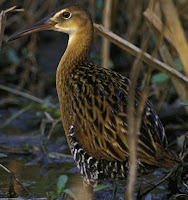KING RAIL
KING RAIL – (Rallus elegans) – (See images below)
DESCRIPTION: The King Rail male has a brown cap and nape, and a mottled brown-dark beige back, wings and tail (which is short and pointed, and often cocked). Undertail is white with dark brown spots. Throat is sometimes creamy. There is a creamy superciliary bar starting from bill base. Breast is cinnamon. Under parts and flanks are finely barred white and brown. Eyes are brown. Bill is longer than head, pointed and brown. Long legs and feet (with long toes) are brown. Female has duller colors. Young are dark brown. Bird length is about 17 inches (45 cm), which makes it the largest rail in North America.
VOICE: https://www.xeno-canto.org/species/Rallus-elegans
NAME: English name ‘Rail’, (and genus name ‘Rallus’) derives from old French and means ‘to make a scraping noise’, in reference to the bird calls. ‘King’ – and Latin species name ‘elegans’ – refer to the bird’s appearance.
HABITAT: Wetlands such as marshes, swamps, rice paddies.
DIET: Crustaceans and insects for the most part. Forages under dense emergent vegetation in shallow water.
NESTING: Nest is a floating platform that may also be above ground. Dummy nests may be built as well. Around seven to twelve light beige eggs are laid, incubated by both parents, who also both feed the young.
DISTRIBUTION: Breeding range includes eastern half of the USA from south of the Great Lakes and except the Appalachians. Winters along the coasts of southeast USA and in the Caribbean.
Distribution Map: https://en.wikipedia.org/wiki/King_rail – /media/File:Rallus_elegans_map.svg
ON PEI: Does not breed on Prince Edward Island, sightings listed as ‘accidental’ so far. See note below on bird vagrancy.
CONSERVATION: Species is listed as ‘near threatened’ by the IUCN, and ‘endangered’ by COSEWIC. Numbers have sharply declined due to habitat loss caused by drainage and pollution from farms.
NOTES: Interbreeds with the Clapper Rail.
Vagrancy: In biology this means an animal going way outside its normal range. For birds, this can happen when there are storms and they get blown off course. On other times, the bird simply wanders in a different direction than usual. Here’s an article about vagrancy in birds.
SIMILAR SPECIES: Virginia Rail
REFERENCES: https://en.wikipedia.org/wiki/King_rail
https://www.audubon.org/field-guide/bird/king-rail
https://www.mba-aom.ca/jsp/toc.jsp (Maritimes Breeding Bird Atlas)
https://www.tn.gov/twra/wildlife/birds/waterbirds/king-rail.html (Tennessee Wildlife Resources Agency)
http://identify.whatbird.com/obj/1000/behavior/King_Rail.aspx
https://guides.nynhp.org/king-rail/ (New York Natural Heritage Program)
https://animaldiversity.org/accounts/Rallus_elegans/ (University of Michigan)
https://txtbba.tamu.edu/species-accounts/king-rail/ (Texas Breeding Bird Atlas)
https://www.allaboutbirds.org/guide/King_Rail/lifehistory
https://www.ontario.ca/page/king-rail (Species At Risk)
DESCRIPTION: The King Rail male has a brown cap and nape, and a mottled brown-dark beige back, wings and tail (which is short and pointed, and often cocked). Undertail is white with dark brown spots. Throat is sometimes creamy. There is a creamy superciliary bar starting from bill base. Breast is cinnamon. Under parts and flanks are finely barred white and brown. Eyes are brown. Bill is longer than head, pointed and brown. Long legs and feet (with long toes) are brown. Female has duller colors. Young are dark brown. Bird length is about 17 inches (45 cm), which makes it the largest rail in North America.
VOICE: https://www.xeno-canto.org/species/Rallus-elegans
NAME: English name ‘Rail’, (and genus name ‘Rallus’) derives from old French and means ‘to make a scraping noise’, in reference to the bird calls. ‘King’ – and Latin species name ‘elegans’ – refer to the bird’s appearance.
HABITAT: Wetlands such as marshes, swamps, rice paddies.
DIET: Crustaceans and insects for the most part. Forages under dense emergent vegetation in shallow water.
NESTING: Nest is a floating platform that may also be above ground. Dummy nests may be built as well. Around seven to twelve light beige eggs are laid, incubated by both parents, who also both feed the young.
DISTRIBUTION: Breeding range includes eastern half of the USA from south of the Great Lakes and except the Appalachians. Winters along the coasts of southeast USA and in the Caribbean.
Distribution Map: https://en.wikipedia.org/wiki/King_rail – /media/File:Rallus_elegans_map.svg
ON PEI: Does not breed on Prince Edward Island, sightings listed as ‘accidental’ so far. See note below on bird vagrancy.
CONSERVATION: Species is listed as ‘near threatened’ by the IUCN, and ‘endangered’ by COSEWIC. Numbers have sharply declined due to habitat loss caused by drainage and pollution from farms.
NOTES: Interbreeds with the Clapper Rail.
Vagrancy: In biology this means an animal going way outside its normal range. For birds, this can happen when there are storms and they get blown off course. On other times, the bird simply wanders in a different direction than usual. Here’s an article about vagrancy in birds.
SIMILAR SPECIES: Virginia Rail
REFERENCES: https://en.wikipedia.org/wiki/King_rail
https://www.audubon.org/field-guide/bird/king-rail
https://www.mba-aom.ca/jsp/toc.jsp (Maritimes Breeding Bird Atlas)
https://www.tn.gov/twra/wildlife/birds/waterbirds/king-rail.html (Tennessee Wildlife Resources Agency)
http://identify.whatbird.com/obj/1000/behavior/King_Rail.aspx
https://guides.nynhp.org/king-rail/ (New York Natural Heritage Program)
https://animaldiversity.org/accounts/Rallus_elegans/ (University of Michigan)
https://txtbba.tamu.edu/species-accounts/king-rail/ (Texas Breeding Bird Atlas)
https://www.allaboutbirds.org/guide/King_Rail/lifehistory
https://www.ontario.ca/page/king-rail (Species At Risk)
 |
| King rail, MO, Jim Rathert, USFWS |
 |
| King rail, VA, by Chris, Sept. 2009 |
 |
| King rail young, IL, Aug. 2011, by Andy Reago and Chrissy McClarren |